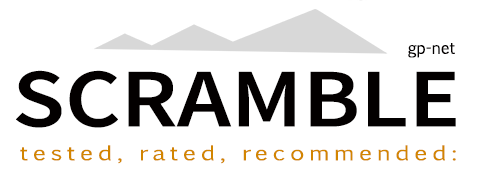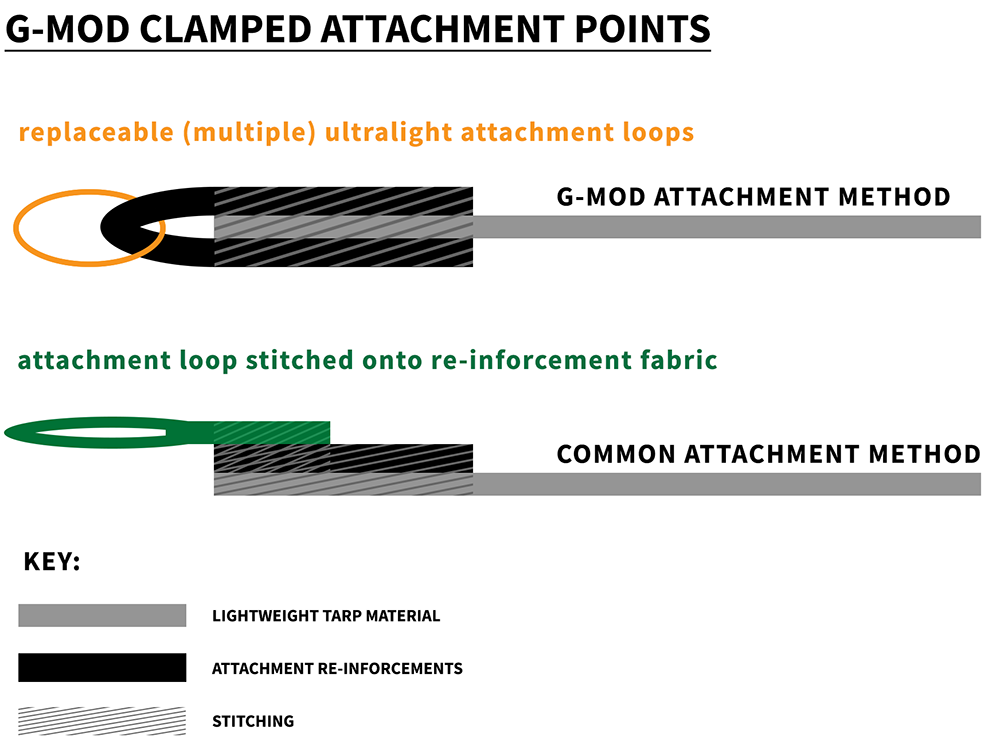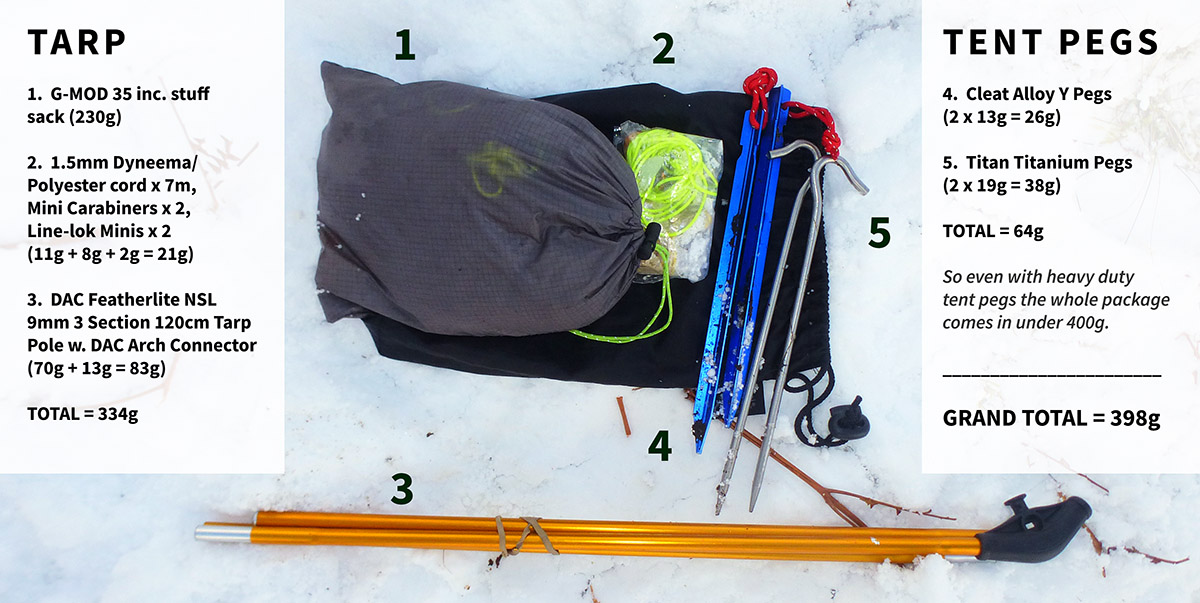This product has been upgraded
Click on the image above or here to see its replacement.
Preface
To understand how we arrived at the (hooped) bivvy + tarp setup, please read our companion post "Reasons To Go Modular".
As always, we're looking at the Scramble G-Mod 35 and G-Mod 38 from the point of view of long distance trekking over tough terrain. Note: These tarps are identical except the 38 is slightly larger than the 35 and thus a fraction heavier too. We think the G-Mod 38 is ideally proportioned, but did most of our testing with the G-Mod 35.
Test subject: Height: 5ft 8"
Test item: G-Mod 35 (Betas & Final)
Kit Tests: Winter, Summer (multiple)
Disclaimer: The G-Mod tarp series are partly manufactured by Scramble. We made them because we weren't happy with existing offerings (as outlined below). So this is less of a review and more an outline of a product. Clearly we think they're the best, otherwise we wouldn't have gone to the trouble of developing them.
Datasheet
| G-MOD 35 & 38 TARPS | |
| Main Fabric: 20D Silicone Coated 360T Ripstop Nylon | - |
| Attachment Points: 420D PU Coated Ripstop Cordura (Number = ) | 8 |
| Attachment Loops: Dyneema/Polyester Cord + High Retraction Elasticated Cord (Corners Only) | 8 x 1.5mm / 4 x 3mm |
| Hydrostatic Head: | 8,000mm |
| G-MOD 35 | |
| Dimensions: Length x Width (Coverage) | 205 x 170 cm (3.49 sqm) |
| Tarp Weight (measured): Tarp + Tarp Bag | ~224g + 6g = ~230g |
| G-MOD 38 | |
| Dimensions: Length x Width (Coverage) | 210 x 180 cm (3.78 sqm) |
| Tarp Weight (measured): Tarp + Tarp Bag | ~274g + 6g = ~280g |
| ACCESSORIES | |
| DAC NSL Pole Dimensions (3 sections, Total Height x Width): | 123cm x 0.9cm |
| DAC NSL Pole Total Weight (measured, 3 sections + ends + arch connector): | 83g |
| Fixings: Cordage, Clips, Line-Loks (Total Weight = ) | 21g |
| PRICES | |
| Scramble's G-Mod 35 (Development) Bargain 30% off on SYSTEM | £37.80 |
| Scramble's G-Mod 35 & 38 (Final) - Introductory Price on SYSTEM | £54.00 |
| DAC NSL Pole (3 Sections) - Scramble's Price on SYSTEM | £21.95 |
Scramble Review
Contents
- Introduction
- Dimensions
- A Brief History
- Materials & Design
- Recommended Accessories
- Stress Testing
- Conclusion, Rating & Product Images
Introduction
The G-Mod 35 and G-Mod 38 tarps were developed to fulfill two primary purposes:
- As an adjunct to a hooped bivvy, an extended "tent porch", providing better than average headroom (100cm) for cooking under, getting changed, and packing / unpacking your gear when it's bucketing down. The G-Mod 35/38 also allows the hooped bivvy to fully vent, reducing the condensation associated with single-skinned shelters, as well as providing protection for all the stuff you can't fit or don't want inside your hooped bivvy.
- As a quick shelter for short breaks in poor conditions during the day.
The G-Mod 35 and 38 are minimalist ultralight tarps, designed to be setup quickly in harsh conditions with minimal fuss. If you enjoy outdoor origami; flirting with myriad tarp configurations then there are many heavier options out there with numerous attachment points to play with. However, we designed the G-Mod tarps for people like us, who sleep on the ground (not in hammocks) and who want something functionally proportioned, that packs down small and is extremely light yet tough enough to deal with the worst mother nature likes to hurl at us.
 Scramble's G-Mod 35 in porch mode over Macpac's Bush Cocoon
Scramble's G-Mod 35 in porch mode over Macpac's Bush Cocoon
For those that like to push the ultralight envelope, there's no reason they can't be used with a bivvy bag, as illustrated in the product images below. But for those that like their bivvy bags (which we do for shorter duration ventures) we've developed the G-Mod 55 (which, due to its larger coverage, allows 2 sides to be completely sealed to the ground, offering more protection from "horizontal" rain).
Dimensions: Sit Up Straight ... Or Not
In "Reasons To Go Modular" we pointed out that outdoor manufacturers of ultralight tarps have either tended to hedge their bets and make a single product for both bivvy and hammock users (two distinctly different use-cases) or have somehow missed the glaringly obvious - that bivvies are waterproof! We assume and hope it's the former.
 A hedged bet? Alpkit's Rig 3.5 (image copyright Alpkit)
A hedged bet? Alpkit's Rig 3.5 (image copyright Alpkit)
For some unknown reason this guy (above right) needs double-glazed water proofing. Bivvy users should, assuming their tarp is well designed, only need waterproof protection from about the waist upward at most (for hammock users it's different; they need the full cover). All that unnecessary length comes at a cost: width.
These solo tarps tend to be too narrow for anything other than being horizontal. If you want to sit upright and actually do stuff while sheltered, good luck. We're not picking on Alpkit (they make fine tarps - just to a specification that we don't understand), Rab's Sil Tarp 1 has very similar dimensions, being only 10cm wider.
Looking at the picture above, simply imagine driving wind and rain. Now imagine the person getting out of their bivvy, getting changed, kneeling and packing up all their gear. It may be okay for sleeping under, but not much else.
What a difference a foot makes
Below we've illustrated the point using two traditional tarp setups, the A-Frame and the Lean-To. First let's look at what it means to sit upright under an A-Framed tarp with a variety of widths.
As you can see, as soon as you sit upright, that 140cm width provides minimal coverage from wind and rain. What's interesting is that it doesn't take a great deal of extra width to make a big difference.
Now if we look at the simplest of "Lean-To" setups. Again we see a similar problem when sitting. Here, the 140cm width, assuming 80cm of headroom, creates such a steep angle, that the avid explorer is forced to sit so far forward that they get almost no overhead coverage at all. The Rab Sil Tarp 1 looks a little better, but again, that extra 30cm or 40cm width makes a big difference and the G-Mod 35 and 38 provide significantly more overhead coverage.
Just for reference, while we're making comparisons, the G-Mod 35 weighs about the same as the Rab Sil Tarp 1 and 70g less than Alpkit's 300g Rig 3.5 (due to its vast army of attachment points). The G-Mod 38 lies between the Rab and Alpkit offerings but provides about 0.4 sqm extra cover.
Shopping Around: A Brief History
When we started testing solo / micro tarps for a quick shelter it soon became clear that 140cm was not wide enough. What surprised us was how difficult it was to find an ultralight tarp with suitable dimensions; we wanted a shorter, wider rectangle, but not a square and we simply couldn't find one. I ended up picking up some "tent footprints" that were ideally sized and sent them out to a few of the Scramble team to play around with.
Footprints, if anything, need to be more waterproof than tarps, when you step on saturated ground the downward pressure your weight exerts forces water up through the fabric (as opposed to rain that just falls and slides off). Generally, for tent footprints to be effective they have to be more heavy-duty than lightweight tarps, but the ones I picked up were too light to be of genuine use on anything but ideal campsite ground. 36g / sqm 20D silicone coated ripstop nylon maybe a strange choice for a footprint, but it's ideal tarp fabric with an impressively high hydrostatic head to boot.
We started testing these in very tough environments to see if they would work as tarps. They performed extremely well in a long series of tests, in high winds and over weeks where it seemed to never stop raining. So we decided to convert them into tarps and began trying out a number of attachment materials and attachment methods. A great deal of testing, refining, and playing around with different materials resulted in the G-Mod 35 and then later the G-Mod 38.
 Scramble's G-Mod 35 during our 2018 Winter Kit Test
Scramble's G-Mod 35 during our 2018 Winter Kit Test
Materials & Design
Made in the UK (Kind of)
The main tarp material is imported prefabricated (silicone coated, edged and seam-sealed) from Geertop in Hong Kong (thus the "G" in G-Mod) along with stuff sacks. Lightweight stuff sack cord, tarp attachment material and attachment loop cord is all imported from Germany. These are then stitched by a small textile company in the UK and we finish them off at Scramble by waterproofing the attachment point stitching using a combination of silicone and PU based sealants, then we add the attachment loops
Attachment Points
We chose 420D PU Coated Ripstop Cordura for the attachment points for its outstanding tear resistance. All 8 attachment points feature 1.5mm Dyneema / Polyester cord loops, which have a breaking strength of 125 kilos yet each 20cm loop weighs just 0.32g. At each corner we've provided an additional attachment option: 3mm high retraction elastic cord. This is substantially stronger and has much less give than traditional shock / bungee cord, and are there when you need to reduce the strain on ultralight tarp poles in high winds. Generally, the corners lowest / pegged to the ground are best attached / pegged down via the elastic 3mm cord.
We decided on a wrap around / clamp design for the attachment points. Traditional attachment points generally have two parts: a reinforcement material onto which is stitched the attachment point. This means there are two points of failure the stitching of the reinforcement onto the tarp and the stitching of the attachment loop onto the reinforcement. The G-Mod's wrap-around design combines these two elements into one piece, reducing the failure points to one. In addition the Cordura attachment point is stitched onto itself essentially clamping the tarp. Further, this allows the user to use any number of materials for their own attachment loops (d-rings, clips, carabiners, other cord loops etc.).
Pole Attachment
G-Mod Tarps will work with any poles but have been designed especially with the excellent DAC 9mm Featherlite NSL poles in mind. These are incredibly strong for their minimal weight. The 3 section pole (available here) stands 123cm tall and weighs just 70g. DAC provide an arch connector (13g) for these poles (its intended use is to join two NSL poles at a 140 degree angle) which makes an excellent attachment point for the G-Mod 35 and 38. 1.5mm Dyneema loops can easily thread through the slit (tested in winter with gloves) and be looped over its protrusion or clipped to a guyline.
 Scramble's G-Mod 35 beta (earlier versions used lower denier Cordura attachment points)
Scramble's G-Mod 35 beta (earlier versions used lower denier Cordura attachment points)
Attachment Loop Options: High Viz or Incognito Black
At each corner there are two attachment options (mentioned above), 3mm high retraction elastic cord for use in high winds and 1.5mm Dyneema / Polyester cord for better stability / rigidity. The G-Mod tarps are available in two options. The default is the high visability option, which features white elastic cord at two of the corners (black on the other two). In poor light it's not always easy to see which is the long side, so we've colour coded the elastic cord, grab the two corners with the white loops and you're holding the short side of the tarp. However, we know some people like to be a little more incognito, so we also offer the tarp with purely black loops (for both the 3mm elastic and the 1.5mm Dyneema).
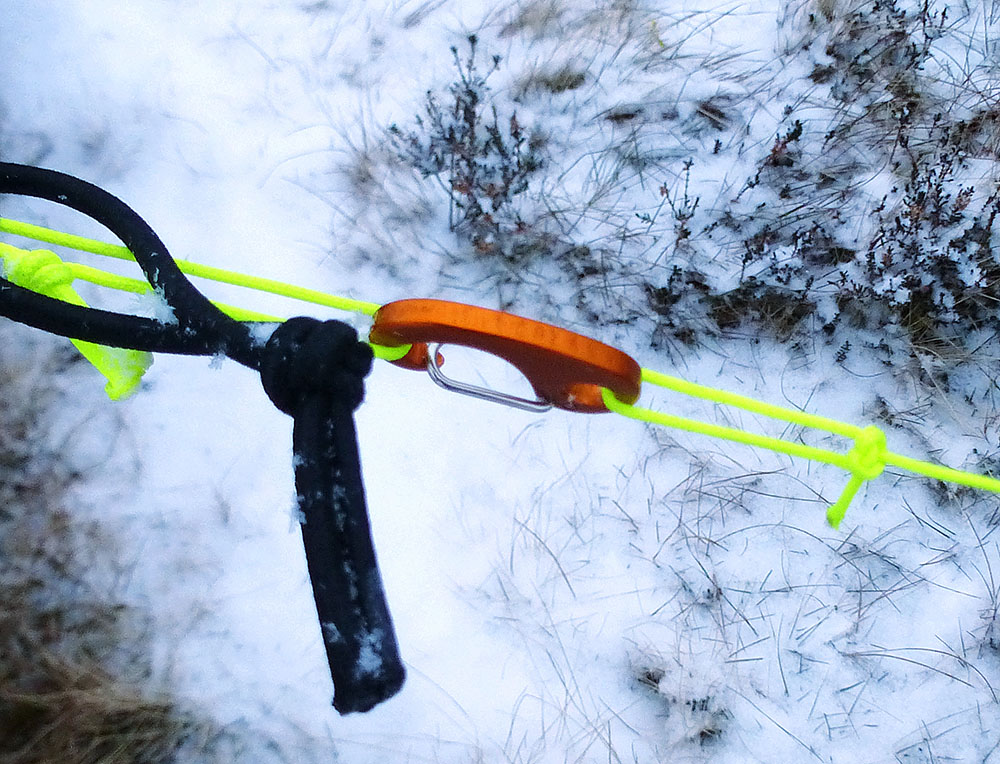 The G-Mod 35 has 2 attachment options at the corners.
The G-Mod 35 has 2 attachment options at the corners.
Recommended Accessories
- Guy line cord: 1.5mm Dyneema / Polyester Cord (we use 2 x 2.5m with line loks and 1 x non-adjustable loop of 2 meters).
- Cord adjusters: Clamcleat Line-Lok Minis (x 2 = 1.5g)
- Guy line attachment clips: Mini Carabiner with Wiregate and Eyelet (35mm x 2 = 8g)
- Pole: DAC Featherlite NSL 9mm Tarp / Tent Pole (3 Sections, ends + DAC Arch Connector = 83g)
- Tent Pegs: Clamcleat Alloy Y Pegs (x 2 = 26g) & Cleamcleat Titanium Titan Pegs (x 2 = 38g)
Note: If we're using the tarp on its own with a bivvy bag, we'll use a (often non-extended) 2-section DAC pole (or anything else we may have that can do the job - see product images below).
The Warranty Voiding Test To Failure
Don't try this at home folks!
One of the most extreme tests we ran when testing the tarp fabric was what we call the "pole test to failure". The purpose is to stress-test the tarp material and, as importantly, to see how easy it is to make a lasting repair in the field. The test is done in exposed areas in the mountains during winter in high winds and involves marking a spot on the tarp fabric (somewhere near the mid-front), then setting up the tarp normally, but pushing the pole end into the actual fabric (rather than attaching it to an attachment loop - this is a stupid thing to do and will void the warranty). We then let the wind do its thing. This is done twice each day (once at night in porch mode and once during the day in quick shelter mode). What are we measuring?
- How long before we wake up with the pole sticking through the tarp material?
- What is the scale and nature of the rip?
- How easy is it to repair in the field?
- How long lasting is the repair?
The test was done 3 times in three very different locations. The average time it took before the fabric gave way was 4.5 days (which is excellent and a testament to the high thread count of the Geertop material). The rip was a pretty standard slit approx 12cm long - so the ripstop "quarantined" the tear. Each tear was able to be repaired with one 20cm strip of Spinnaker Repair Tape on the top side. On return this was then reinforced by coating the under side of the ripped area using Goop Marine adhesive (to waterproof the repair) and then applying another strip of Spinnaker Repair Tape to the underside (over the sealant). In all cases these test tarps are still going strong and are still completely waterproof. Below is my test G-Mod 35 (which has been through the mill) pictured in 2018; the pole stress-test had been conducted in 2016.
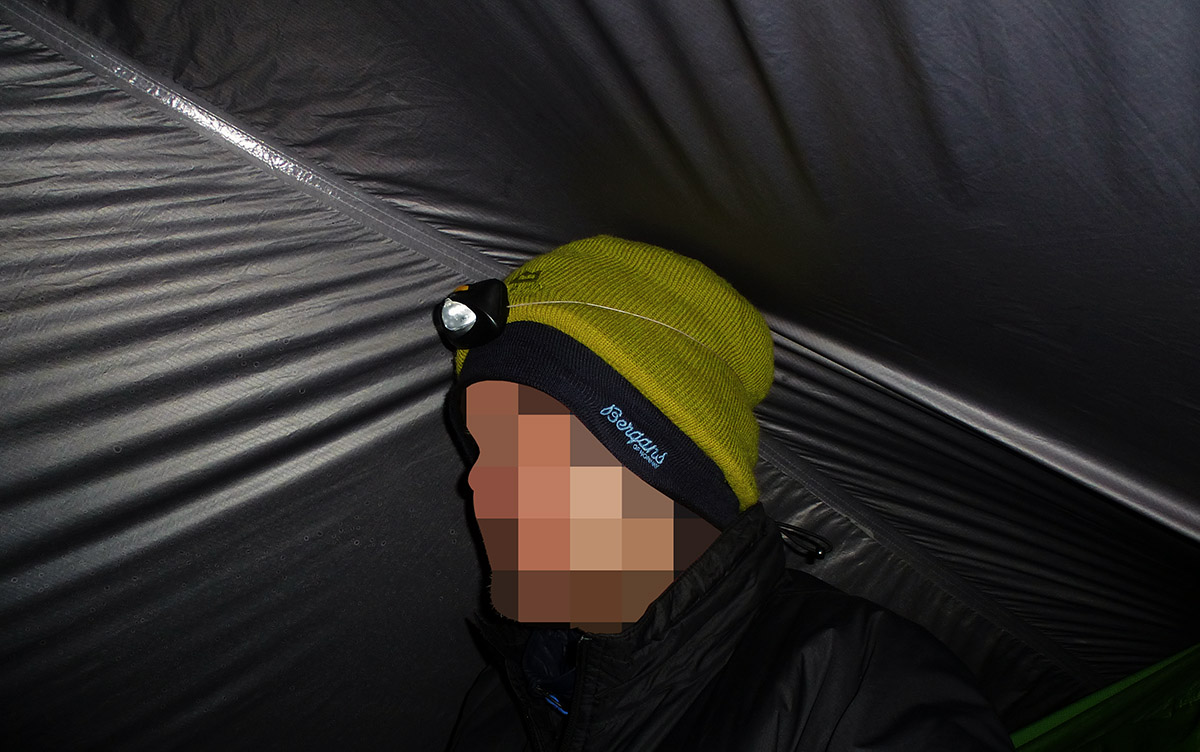 Plenty of shelter sitting under the my test G-Mod 35
Plenty of shelter sitting under the my test G-Mod 35
Conclusion & Rating
The G-Mod 35 and 38 are minimalist, ultralight tarps designed to be setup quickly in harsh conditions with minimal fuss. Targeted specifically at bivvy, hooped bivvy and UL tent users, the G-Mod 35 provides 3.5 sqm of cover (and the G-Mod 38, 3.8 sqm) with enough width to offer meaningful shelter in stormy conditions. Colour coded, high retraction attachment loops aid setup in low light conditions and help reduce stress on ultralight tarp poles in high winds, while Cordura reinforcements and Dyneema/Polyester cord loops offer superb tear resistance and load tolerance. With an impressively small pack size and weighing in at around 230g (including stuff sack for the G-Mod 35) and 280g (for the G-Mod 38) these tarps may be lightweight but have proven, over years of testing, that they're tough enough to handle themselves in extremely challenging conditions.
We made the G-Mod 35 and 38 because we weren't happy recommending UL tarps that simply didn't serve our purposes. Sometimes if you want something done properly you've got to do it yourself - we're very happy we did. The G-Mod 35 and G-Mod 38 are Scramble's, unashamedly, top picks in the UL Solo Tarp category and our recommendation for anyone who has Reasons To Go Modular.
Product Images
Rating (out of 10)
Scramble make the G-Mod tarps, and while we've tried to give a rating as objectively as possible (partly based on the idea of what the competition would have to improve upon for us to throw in the towel) please take this rating with a certain amount of salt.
* The value score is derived from two factors:
1) Competitive Market Price (CMP). This represents our judgement of a competitive online price point if we were to stock the item. e.g. if we feel we would need to sell an item at 40% off (i.e. 60% of its full RRP) to be competitive, then our CMP score will be 6/10.
2) Customer Value Price (CVP). We then make an honest appraisal of the maximum price we would be willing to pay for the item (and we're mean). So if we'd pay 80% of its RRP our CVP score would be 8/10.
We then average the two scores to get our final value score, which in our example would be 7/10.
Last Updated: 19/05/18
